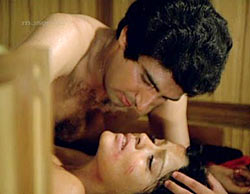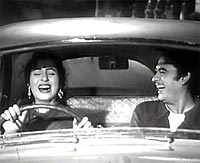 | « Back to article | Print this article |
 Rinki Roy, daughter of noted director Bimal Roy, pens her thoughts on how women have been portrayed in Hindi cinema through the years, and why the stereotyping should STOP!
Rinki Roy, daughter of noted director Bimal Roy, pens her thoughts on how women have been portrayed in Hindi cinema through the years, and why the stereotyping should STOP!
As an activist, I have worked with media colleagues challenging stereotyped women's images on screen -- both cinema and on television. We protested against women being portrayed in a demeaning manner.
Some of the earliest films that came in for indecent portrayals were Pati Parameshwar, Red Rose, Insaaf Ka Tarazu and Zakhmee Aurat. These films depicted women as hapless victims or ruthless avengers -- both too exaggerated and untrue.
I still remember a notorious TV spot for a detergent company. It showed a young woman cleaning the toilet while her husband reads the newspaper! These flawed images, naturally, made our blood boil.
We campaigned till they were hauled off the air.
I actually got a film banned! I S Johar's Jai Bangladesh only portrayed women with scandalous crudity -- it trivialised something as serious as rape.
Cashing the Bangladesh sentiment, the makers of the film depicted serial rapes in all its gory, graphic details. The agenda was crystal clear -- obsession with the female anatomy. Titillate.
A Bangladeshi actress, Kaveri Chowdhury, was hired to make it authentic. The film was nothing but soft porn. Protests poured in from our disgusted Bangladeshi friends in exile at this crude exploitation of a newly emerging nation. When my letter to the I&B Minister was printed in an underground magazine -- The People, a Bangladeshi mouthpiece -- it worked like magic. Seventy prints of Johar's film were promptly withdrawn from theatre. So much for media power and activism.
With my background of activism and women's concern, female representation on screen, naturally, fail to appeal. Mainstream cinema women remain stereotyped, hyped, caricatured. Mothers, wives, sisters, girlfriends, vamps are poured into formula moulds -- they are unreal mythical creatures.
Created by the dangerous collusion of male lust and patriarchal values, the images are a far cry from what women really are.
The camera's male gaze further distorts them. Some images are so offensive to women that they humiliate.
In this gargantuan body of thousands and thousands of Indian films being churning out, I have not found female characters I can identify with -- or admire.
Those I do, belong to sensitive works by non-mainstream practitioners. It makes an interesting journey to ruminate on some of these rare yet happy exceptions.
 Madhubala's character in Satyen Bose's Chalti Ka Naam Gadi (1956) is a top favourite. Her breezy performance stands out as that rare example of an independent, urban woman. She is no coy, pallu-twisting heroine, who make the majority -- but a gutsy, fun loving woman who drives her car, and her man, with equal aplomb.
Madhubala's character in Satyen Bose's Chalti Ka Naam Gadi (1956) is a top favourite. Her breezy performance stands out as that rare example of an independent, urban woman. She is no coy, pallu-twisting heroine, who make the majority -- but a gutsy, fun loving woman who drives her car, and her man, with equal aplomb.
Madhubala's sparkling persona rubbed itself on most parts she played, in films like Howrah Bridge and Kala Bazaar. In Mahal, as the ethereal, nameless woman who vanishes like the mist, her enigmatic charm created a persona hard to match. For me, Madhubala is the face of the original celluloid diva.
Bankim Chatterjeei's Debi Choudhurani -- an iconic creation in Bengali literature -- was a 1940s film. Played by the divinely beautiful actress Sumitra Devi as Prafulla, she was the first woman character who hit me between the eyes.
In the film, Prafulla is a beautiful wife abandoned by her wealthy zamindar husband for not bringing in enough dowry. Sagas of neglected wives are the salt of Bollywood. The most eloquent is, of course, Choti Bahu of Saheb Biwi Aur Ghulam.
As the childless, lonely Bibi, Meena Kumari gave a sumptuous profile of feudal decay in the Guru Dutt version. Like Devdas, she drowns her sorrow in drinking and self annihilation.
There was Mita in Basu Bhattacharya's Anubhav, Hrishikesh Mukherjee's Anuradha, Jabbar Patel's bilingual films Umbartha and Subah, and Vijay Anand's Guide amongst other tales of failed marriages.
However, no one rises like a phoenix like Prafulla. A determined woman, she devises a unique strategy for sweet revenge by regaining her status in the marital home. Rejected due to her humble stock, poverty and inadequate dowry, Prafulla's life turns on its head, as does the story -- when the dreaded robber baron abducts her. Her fearlessness, intelligence and dazzling beauty wins over the aging robber.
Prafulla becomes his worthy successor. On his death, she earns the title of 'Debi Choudhurani'.
As her fame spreads far and wide, she proves women can equal men in group leadership, cunning and wealth creation. When her husband is on the point of penury, it is Prafulla's wisdom and wealth that saves him.
Bankim Chandra's novel with its feudal setting stayed with me from the time I saw the film aged of five or six. So powerful and tantalising was this female Robin Hood that many directors, including my father (Bimal Roy), considered a Hindi remake.
 Of the many memorable female characters in Bimal Roy's movies is Parvati (Devdas). Paro was far ahead of her times. What never fails to amaze me is her ability to take radical initiatives. She walks boldly into Devdas's bedroom in the dark of night, urging him to marry her. Her boldness wrecks Devdas. More concerned about a stigma on his reputation, he buckles down.
Of the many memorable female characters in Bimal Roy's movies is Parvati (Devdas). Paro was far ahead of her times. What never fails to amaze me is her ability to take radical initiatives. She walks boldly into Devdas's bedroom in the dark of night, urging him to marry her. Her boldness wrecks Devdas. More concerned about a stigma on his reputation, he buckles down.
Again, Parvati defies social norms by her love for Devdas as a married woman. She sees nothing wrong in bringing her ailing childhood sweetheart to her marital home.
Confidently, she assures her grown-up step-son that there was no harm in her decision. No culture allows married women to openly flaunt their lovers, inviting them home would wreck havoc. One hears of ménage a trios -- but that is a rare exception.
The riverbank scene when she confronts Devdas is specially moving. Devdas, who rejected Paro in haste, suddenly proposes marriage because he fears losing her. Incensed, Parvati lashes out: 'Are you the only who has parents and who upholds family prestige? I have parents too. They care for their family honour as much! I cannot keep pace with your flippant mood changes.'
It is occasions like these that justify the famous lines: 'Hell hath no fury like a woman scorned.'
In spite of the way Devdas treats her, Paro's loyalty to him is praise worthy. What about Chandramukhi? She is, after all, a mirror image of Paro. She too posses these qualities, she too is worthy of adulation -- perhaps more than Paro.
Many women from my father's films appear like real people because he portrayed women from the middle class intelligentsia and chose narratives that defined values and aspirations of that class.
His Dalit heroine Sujata, whose caste clings to her like a thorny vine is not vocal like Paro. No, she is passive and shy. Sujata has accepted her place in the world. The sudden shift occurs when a idealist falls in love with Sujata. His attempt to reinvent her -- give her a sense of self -- confuses Sujata. Her struggle is to come to terms with the new reality which the unknown road offers.
A feminist friend had pointed, dismissively, that the women in Bimal Roy films eventually go back to the kitchen, make tea, cook, or end up with family obligations. Meaning, the Bimal Roy women return to domesticity and social conformity. Women are trapped in conformity, in traditional role models -- where were the escape routes or options outside these for women in the 1940s or 50s?
In the films of Debaki Bose, Barua, Guru Dutt, Mehboob, V Shantaram and Bimal Roy we found intelligent and realistic women.
Then came an era of systematic neglect. But a change is beginning to be seen. Non-mainstream cinema has opened up, and the women portrayed in them are fun to watch. For example, Tere Bin Ladin, Phaas Gaye Re Obama and Vicky Donor treat serious subjects in a lighter vein.
The ultimate dream of the office-assistant in Tere Bin Laden is to run a beauty parlour. Coming from the working class, this is logical. She is no heroine material for mainstream cinema. It is reassuring to find someone as ordinary on screen.
Another beauty parlour owner is Vicky's mother in Vicky Donor. At the end of a hard day's work, she and her mother-in-law down a few pegs, curse, complain and continue to eke out an ordinary life in a Lajpat Nagar barsati. Vicky's Bengali girlfriend, working in a bank, is another refreshing example. Who imagined such everyday people as Hindi film heroines?
Writer-directors Zoya Akhtar and Reema Kagti create zesty young women with modern sensibilities. Female parts in their works are written to project individuals who are real and convincing.
The women characters in Anurag Basu's Dev D were interesting and the ending -- Dev D walking away into the sunset with Chanda -- is an intresting innovation of the old Devdas theme.
After watching Jabbar's Patels' Subah -- about a discontent wife seeking fulfillment by working in a women's remand home until she is utterly disillusioned -- I feel films could begin where Subah ends. The film ends showing the woman journeying towards a nameless destination.
Since Henrik Ibsen's celebrated play Doll's House, writers have made women leave home as a statement of their coming of age and self assertion. But the statement is no longer radical. What happens to a woman after she leaves her marriage? That is the real concern.
I am waiting to see a film begin when a woman leaves home, her husband, family and marriage. Where are stories of women punished by the judicial system for raising their voices for equal justice? There was the solitary No One Killed Jessica. Many more films on these important subjects need to come out on the Indian screen.
In a country where the sex ratio has collapsed to 940 females to 1000 males, where a woman is raped every 34 minutes, molested every 24 minutes, killed every 93 minutes -- both media and the society -- have far greater social responsibility. Cinema cannot be only entertaining. Serious filmmakers know this and have shown greater sensitivity but they will always be in minority.
Filmmakers cannot afford to forget that thousands watch films. It is extremely irresponsible to release a film which gives out the wrong signals about gender roles. Portraying women, men and children truthfully is their responsibility. Someone has to halt objectification of women on mainstream cinema. It is time mainstream makers pulled themselves out of dark ages and behaved like responsible adults.